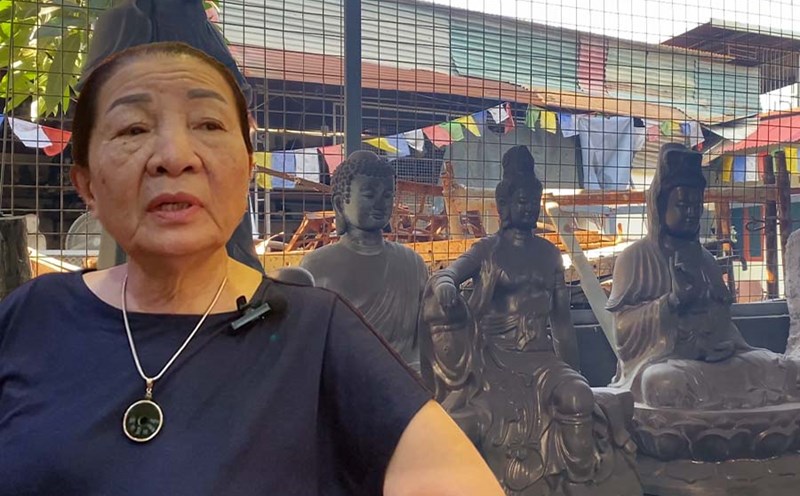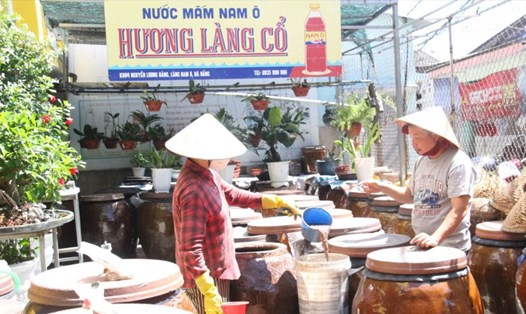Many difficulties to keep embroidery profession
Visiting the embroidery village in Quat Dong commune, Thuong Tin district, Hanoi, the establishments selling embroidered paintings and operating embroidery workshops are sparse. According to the reporter's records, within about 10km of km30 on National Highway 1A, there are up to 6 villages with gates hanging signs "traditional embroidery village". However, there are almost no households practicing embroidery, no embroidery painting establishments, no hand-embroidered handicrafts still operating.
It was very difficult to find Mr. Nguyen Van Hop's embroidery workshop, located on km26 of National Highway 1A. This facility has been in operation for about 30 years. According to Mr. Hop, during the period when embroidery was prosperous, the embroidery profession was very developed.
“About 20 years ago, the embroidery village was bustling, it must be said that every house embroidered, every person embroidered, every household made embroidered pictures, embroidered shirts, embroidered handkerchiefs to sell. By 2015, the demand for embroidered pictures decreased a lot, people no longer stuck to the profession. The peak was after the COVID-19 pandemic until now, in the whole Quat Dong commune, there are only a few establishments remaining,” Mr. Hop shared.
Nguyen Van Hop’s painting production facility has a variety of prices, ranging from 500,000 VND to 2 million VND depending on the size and complexity of the painting. In particular, he focuses on producing “tourist paintings”, which are paintings embroidered with images of famous landscapes and historical sites for sale at tourist destinations such as Hanoi’s Old Quarter, Sa Pa, and Da Nang.
Mr. Hop shared that even large-sized embroidered paintings of four panels, horses returning successfully, and landscapes to hang in the living room only cost a few million VND. Not to mention, hand-embroidered paintings also have to compete fiercely with computerized embroidery (mass-produced by modern digital computers). Currently, Mr. Hop's facility earns about 10-15 million VND per month in revenue. Each embroiderer, depending on their skills, receives a salary of 5-6 million VND per month, working 9 hours per day.
Fear of the craft village disappearing
Van Phuc silk village is also one of the famous traditional craft villages of the capital, having existed for more than 1,000 years. If at the beginning of 2023, the village had approximately 800 households participating in silk production, accounting for 60% of the village's population, now this number has "evaporated" quite a bit. The village only has about 400 households participating in silk production, 244 households producing in the craft village industrial cluster with about 70 types of silk, silk, brocade, linen... serving domestic customers and for export.
In the weaving workshops, the number of weaving machines and weavers is quite sparse, only a few people/household. Notably, most of the skilled workers are in their 60s and 70s; there are few young workers. The shops sell a variety of silk products with different colors, qualities, and designs, with prices ranging from a few tens of thousands to millions of VND/item.
Ms. Nguyen Thi Phu - a silk weaver from Van Phuc village with more than 60 years of experience in the profession shared: "In the past, during the golden age of Van Phuc silk, the work of reeling and weaving took place continuously, sometimes lacking human resources, weaving machines, silk threads... However, now, the work is not as much as before. In a month, I receive reeling for a few houses but not continuously, sometimes I have the whole day off."
Finding a way forward for traditional craft villages
Faced with the changes of the times, embroidery and silk weaving in particular and traditional craft villages in general face many difficulties and are at risk of being forgotten and lost in the flow of contemporary life.
To preserve traditional craft villages that have existed for hundreds of years, there needs to be plans and innovations in the approach to this heritage source that is both rich in cultural value and rich in economic potential. Accordingly, developing craft village tourism has become an effective direction that Hanoi has implemented in recent years.
Tourists coming to Hanoi’s craft villages will be able to visit the production site, listen to the story behind each traditional handicraft product, interact with craftsmen and participate in some stages of producing their own small items. In return, craft villages will have the opportunity to introduce and promote local products, attract visitors to see and buy as gifts, and even promote international integration and trade.
Mr. Phung Quang Thang - Permanent Vice President of the Vietnam Tourism Association - commented that there is still much to do to link the profession with tourism services. In particular, it is necessary to pay attention to sustainable tourism development, including environmental protection and rural agricultural ecosystems.
Tourism creates more jobs and income, the quintessence of craft villages will be preserved and promoted, and at the same time contribute to building the image of a locality that is not only rich in economy but also profound in culture.















